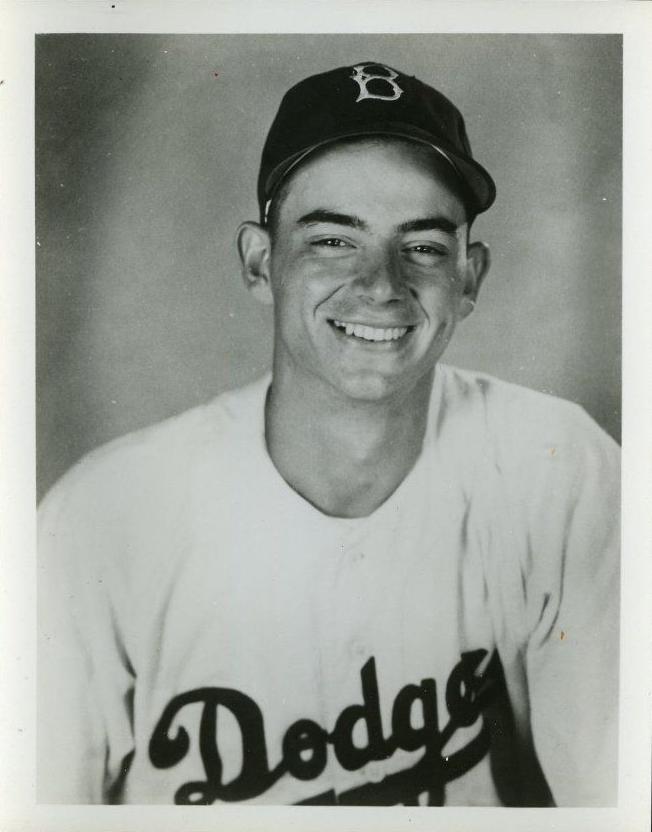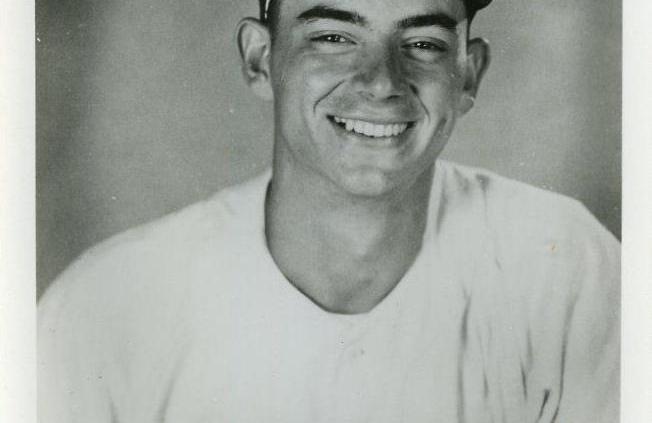September 18, 1950: Tommy Brown hits unlikely 3 homers for Dodgers
 Tommy Brown first gained notoriety as a 16-year-old for the Brooklyn Dodgers in 1944. His unique opportunity to reach the big leagues at such a young age came about because most of baseball’s regular players were serving in the military during World War II. He would be a part-time player during his entire nine-year major-league career that included only 31 home runs. Consequently, his improbable three-homer game on September 18, 1950, was one of the highlights of his career. Yet his feat that day was minimized by the Dodgers’ frustration from extending their decline during a race for the pennant.
Tommy Brown first gained notoriety as a 16-year-old for the Brooklyn Dodgers in 1944. His unique opportunity to reach the big leagues at such a young age came about because most of baseball’s regular players were serving in the military during World War II. He would be a part-time player during his entire nine-year major-league career that included only 31 home runs. Consequently, his improbable three-homer game on September 18, 1950, was one of the highlights of his career. Yet his feat that day was minimized by the Dodgers’ frustration from extending their decline during a race for the pennant.
The way Brown initially got into Organized Baseball was also improbable. The teenager had quit school at a young age to work on the docks in New York City. At the urging of a friend, he attended a tryout with the Dodgers in 1943 without a glove and spikes. The 15-year-old was among a handful of players from a pool of 2,500 hopefuls who were called back by the Dodgers for a further look.1 He signed a minor-league contract that took him to Class B Newport News for the 1944 season.
There, Brown hit .297 in 91 games and was called up to the Dodgers at the beginning of August. Leo Durocher was the manager of the Dodgers team, whose offense was credible but whose pitching was last in the league. With Pee Wee Reese still in the Navy, Durocher had tried several players at shortstop, including Bobby Bragan, Eddie Stanky, Bill Hart, and Gil English, but none of them had distinguished themselves.
Brown was thrown into the starting lineup right away, making his debut on August 3 and getting a double in four at-bats. He is still the youngest position player (16 years, 241 days) to debut in the majors.2 The seventh-place Dodgers weren’t going anywhere, so Durocher stuck with Brown as his everyday shortstop, even though he was erratic with his fielding (16 errors) and displayed a weak bat (.164) in 46 games.
Brown didn’t want to stay with the Dodgers. He said, “I needed schooling and experience. I wanted desperately to go back to the minors. I wasn’t ready.” He appealed to Branch Rickey to be sent back down, but Rickey obliged him only after the regular players returned from the war.3
With Reese firmly entrenched at shortstop, Brown was moved to the outfield during the 1949 season. Manager Burt Shotton used him as one of several outfielders he shifted in and out of the lineup, practically using the left-field position in continuous platooning fashion. Duke Snider and Carl Furillo were everyday starters in the other two outfield positions.
Still only 22 years old in his sixth major-league season in 1950, Brown was referred to by the Brooklyn Daily Eagle as the “perpetual rookie,”4 while the New York Times called him the “youngest ‘veteran’ in the big leagues.”5
Brown had an odd practice of keeping track of the home runs he hit during batting practice. By his count, he had 170 for the season going into the game on September 18.6 Yet he seemed to have trouble making contact during actual games, having hit only two home runs for the season. Prior to 1950, he had a total of seven in 650 plate appearances.
The Dodgers were one of the favorites to contend for the National League pennant in 1950 after having fielded one of the franchise’s best teams ever when they won the pennant in 1949.
It appeared the Dodgers would fulfill the expectations when they held a slight lead in the standings as late as June 29. However, the surprising Philadelphia Phillies Whiz Kids overtook the Dodgers, and during the first two weeks of July, Brooklyn fell to fourth place behind St. Louis and Boston.
Going into the game on September 18, the Dodgers were in third place after a three-game losing streak and lagged the leading Phillies by 8½ games. Shotton had come under fire for the team’s recent lackluster performance.
Before a paid attendance of 2,051, the Dodgers’ smallest crowd of the season at that point, the Cubs’ Randy Jackson led off the game with a home run against Preacher Roe, an 18-game winner at this point.7
Roe was not up to his usual form, and his troubles became more evident in the third inning when he walked three and gave up a single before Mickey Owen doubled in Hank Sauer and Roy Smalley. A third runner, Wayne Terwilliger, was called out at home on a throw from left fielder Brown.
Facing former Dodger Paul Minner in the bottom of the third, Brown hit a home run to left field with Roe on base. It was his third home run of the season, which equaled his career high.
Leading off the Dodgers’ fifth with the team losing 3-2, Brown tied the game with his second home run, hit to left off Monk Dubiel, who had replaced Minner in the third.
In the Cubs’ seventh, Roe allowed a leadoff double to Hal Jeffcoat, who was sacrificed to third by Preston Ward. After Hank Sauer walked, Andy Pafko singled to break the tie. A walk to Terwilliger loaded the bases, at which point Shotton summoned Dan Bankhead from the bullpen. In a game of chess, Cubs manager Frankie Frisch countered with pinch-hitter Ron Northey in place of Owen, and it paid off. Northey cleared the bases with his ninth homer of the season and the eighth grand slam of his career.
A seemingly comfortable 8-3 lead by the Cubs turned out not to be the case in the bottom of the eighth inning. With one out, Cal Abrams singled off Dubiel, and Brown followed with his third home run to left field. Then Reese singled and scored on Snider’s single and a wild throw by third baseman Randy Jackson. With Dutch Leonard in the game relieving Dubiel, Hodges followed with another single that scored Snider. With the score 8-7 and the tying run on base with one out, Leonard retired the side without allowing another run.
The Cubs made it 9-7 in the ninth when Terwilliger hit a solo home run off Billy Loes. Leonard retired the Dodgers in order in the bottom of the ninth.
Despite the loss, Brown had the best performance of his career. He went 4-for-4 with a single and a walk besides his three homers. He drove in five runs. But his amazing outing was overshadowed by Northey’s grand slam, and Dodgers pitchers gave up 12 hits and nine walks, including eight by Roe, who took his 11th loss of the season. Dubiel got credit for the win even though he gave up five earned runs in his five innings.
In a dejected clubhouse, Shotton said, “Perhaps there was some way to win a ballgame like that one. But if there was one, I don’t know it.”8
The Dodgers extended their losing streak to four games, putting them nine games behind the Phillies and 1½ games behind Boston. However, they rebounded to win 13 of their last 17 games of the season. With a chance to tie for the league lead in the last two games of the season against the Phillies, the Dodgers came up short by losing the final game in a classic matchup between 19-game winners Robin Roberts and Don Newcombe.
The Dodgers were able to get added power from Pafko in left field and finally gave up on Brown by trading him to the Phillies in June 1951. He also played two seasons with the Cubs in 1952 and 1953, then ironically spent six years in the minors before retiring at age 31 in 1959.
SOURCES
In addition to the sources cited in the Notes, the author consulted Baseball-Reference.com and the following:
“Northey’s 4 Run Pinch Homer Helps Cubs Beat Dodgers, 9-7,” Chicago Tribune, September 19, 1950: 3,1.
NOTES
1 C. Paul Rogers III, “Tommy Brown,” SABR BioProject. sabr.org/bioproj/person/7913ae6c.
2 Joe Nuxhall, a pitcher with the Cincinnati Reds in 1944, was the youngest player (15 years, 316 days) in history.
3 Tim Pinacchio, “How It Was During the War Years,” Baseball Digest, January 1977: 67.
4 Tommy Holmes, “Dodger Slide Dims Brown’s 3 Homers,” Brooklyn Daily Eagle, September 19, 1950: 13.
5 Roscoe McGowen, “Brooks Beaten by Chicagoans, 9-7, Despite Brown’s 3 Homers, Single,” New York Times, September 19, 1950.
6 “Flock Eyes Bucs for Victory Tonic,” Brooklyn Daily Eagle, September 19, 1950: 13.
7 Roe finished the season 19-11.
8 Holmes.
Additional Stats
Chicago Cubs 9
Brooklyn Dodgers 7
Ebbets Field
Brooklyn, NY
Box Score + PBP:
Corrections? Additions?
If you can help us improve this game story, contact us.


